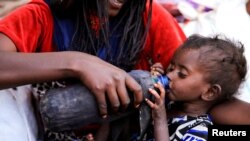The United Nations humanitarian agency in Ethiopia said Thursday it has been getting increasing amounts of aid to the embattled northern Tigray and Afar regions. But in its latest report, the U.N. Office for the Coordination of Humanitarian Affairs said malnutrition rates are critical and alarmingly high. Despite a November peace deal between Ethiopia’s federal and Tigrayan authorities, the U.N. said access to provide aid remains difficult in some areas.
The United Nations Office for the Coordination of Humanitarian Affairs in Ethiopia says from mid-November through December more than 3,000 trucks of food, health, and shelter aid were sent to Tigray region.
In its latest report Thursday, the agency said in the last week of December alone it assisted 368,000 people in Tigray with food aid, some of which was also sent by air.
But the biweekly report said malnutrition rates were alarmingly high, with one third of children and two-thirds of pregnant and lactating women screened in December found to be acutely malnourished.
Despite the Ethiopian government allowing increasing amounts of aid to Tigray since a November peace deal, the U.N. report said some areas were still out of reach.
It said organizations working with the U.N. had assisted about 60% of 5.4 million people targeted for help in Tigray since October.
A U.N. spokesperson in Ethiopia was not immediately available to comment.
Debebe Zewdie, spokesman for Ethiopia’s National Disaster and Risk Management Commission, says they have reached areas other aid groups cannot, including border areas near Eritrea, where they have given food to about 81,000 people.
Debebe says food assistance has been given to more than 8 million people in need of support in the northern part of the country, including Tigray, Amhara and Afar.
The November peace deal between Ethiopia’s federal government and the Tigray People’s Liberation Front ended two years of war and lifted aid and services blockades to the region.
Ethiopia in December restored water, power, and telecommunications in several towns in the region as well as commercial flights to the capital, Mekelle.
While fighting has calmed in Tigray, clashes are being reported in Ethiopia’s southern Oromia region.
Ethiopia’s Oromo and Amhara ethnic groups blame each other for allegedly deadly attacks since November.
The U.N. report said aid access to Oromia region was difficult, with ongoing conflict displacing more people.
It said as of December 30, more than 14,000 people fleeing conflict from Oromia arrived in Amhara region.









